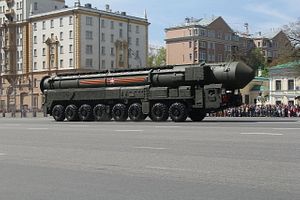Russia tested a new and experimental type of intercontinental-range ballistic missile multiple warhead delivery method in September 2017, the Diplomat has learned.
According to a U.S. government source with knowledge of a recent U.S. intelligence assessment of Russian ballistic missile testing who spoke to the Diplomat, Russia’s strategic missile force recently tested an independent post-boost vehicle (IPBV) configuration for a three-warhead version of its solid-fuel, road-mobile RS-24 Yars ICBM.
The test was carried out on September 12 from a silo at the Plesetsk Cosmodrome in Archangelsk Oblast, striking at targets at the Kura Missile Test Range in Kamchatka Krai. It occurred just days before the start of the massive Russia-Belarus Zapad-2017 military drills. It’s unclear if this was the first test of an IPBV configuration on a Russian ICBM.
A Russian Defense Ministry official told the country’s state-run TASS news agency that the September 12 test involved an experimental “detachable” warhead design. The test was reportedly successful.
Multiple independently targetable reentry vehicle (MIRV) capable ICBMs normally feature what’s known as a post-boost stage that can maneuver while outside the earth’s atmosphere—after the launch vehicle’s powered flight has concluded at high altitudes—to dispense individual warheads to multiple targets at different approaches, allowing a single ICBM to strike targets separated by great distances.
The independent post-boost vehicle configuration tested by Russia is based on a similar concept, but would presumably allow for more complex and flexible targeting off a single ballistic missile in midcourse. Post-boost vehicles are not considered to be a separate missile stage as they do not generally enhance range; they can allow for more precise guidance and targeting.
It’s unclear if the September 12 test also involved penetration aids and decoys, which could help the missile bypass existing U.S. ballistic missile defense systems.
Russia and China operate a range of MIRV-capable ballistic missiles. MIRVs generally allow for a most cost-efficient mode of nuclear targeting, given that the costs of manufacturing additional nuclear warheads and reentry vehicles is lower than the cost of manufacturing more ballistic missiles.
The United States’ only active ICBM, the Minuteman III, was designed to be capable of delivering three warheads to multiple targets, but the current missiles on alert feature a single high-yield warhead. The Trident II D5, the United States’ only submarine-launched ballistic missiles, features four to five warheads, though each can carry as many as eight.
Russia’s September 12 test-launch of the Yars ICBM was followed by a transporter-erector-launcher-based launch of the RS-12M Topol ICBM on September 20 from Kapustin Yar.
That test involved the demonstration of what the Russian Defense Ministry described as an “advanced combat payload,” but did not involve similar experimental midcourse maneuvering technology.
Correction: An earlier version of this article suggested that the launch took place at the Kura range. It struck targets at Kura, but was launched from Plesetsk.

































